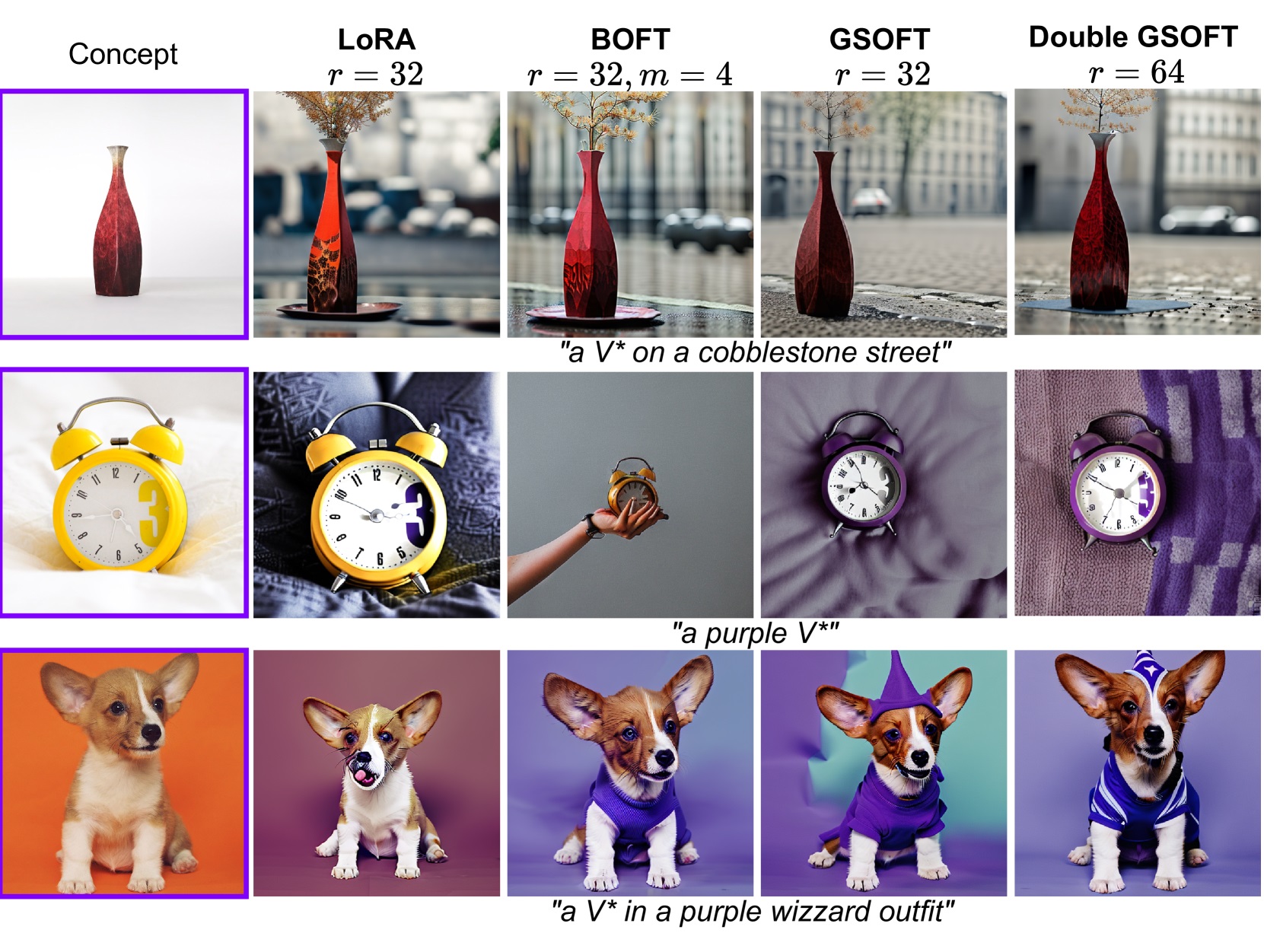Group and Shuffle: Researchers at HSE University and AIRI Accelerate Neural Network Fine-Tuning

Researchers at HSE University and the AIRI Institute have proposed a method for quickly fine-tuning neural networks. Their approach involves processing data in groups and then optimally shuffling these groups to improve their interactions. The method outperforms alternatives in image generation and analysis, as well as in fine-tuning text models, all while requiring less memory and training time. The results have been presented at the NeurIPS 2024 Conference.
The larger the neural network, the more challenging it becomes to quickly adapt it to a new task. Retraining a model from scratch is a time-consuming and costly process. Therefore, developers seek cost-effective ways to adapt a model to a specific task while preserving the overall quality of the original.
One such approach is fine-tuning using orthogonal matrices, which, unlike other methods, preserve the essential features of the original model. Popular alternatives, such as block-diagonal or butterfly matrices, have drawbacks: they are either limited in scope or require extensive computations.
Researchers at the HSE Faculty of Computer Science and the AIRI Institute have proposed a new method of constructing matrices, which they call Group-and-Shuffle. Instead of working with all the data at once, they divide the parameters into small groups, process each group separately, and then shuffle them together. This structure is both flexible and efficient: it enables the model to adapt more precisely to the task while requiring fewer computations and less memory.
Building on GS matrices, the researchers developed GSOFT, a new method for orthogonal fine-tuning of neural networks. Unlike previous approaches, GSOFT uses fewer parameters while maintaining training stability and quality, even with limited data. The team also introduced a two-sided version of the method—Double GSOFT—which allows simultaneous adjustment of parameters from both sides, enhancing the model’s flexibility and accuracy.
'We discovered how to construct orthogonal matrices using only two special types of matrices, instead of five or six as required by previous methods. This saves computational resources and training time,' explains Nikolay Yudin, Research Assistant at the HSE Laboratory for Matrix and Tensor Methods in Machine Learning.
The researchers tested the approach on three types of tasks. When fine-tuning the RoBERTa language model, the method outperformed others while using a comparable number of parameters. In image generation, where the model needed to preserve the original features while adapting to the user’s request, GSOFT and Double GSOFT outperformed popular methods like LoRA and BOFT, all while using less memory and training time.

The authors also tested their approach on convolutional neural networks, which are commonly used for image and video analysis, such as in face recognition. The team adapted the GS matrices even for cases where the model required strong resistance to interference and distortion.
'We tested the method across various scenarios—from language and generative models to robust convolutional networks. In every case, it performed reliably while using fewer resources. This confirms that the method can be applied effectively to a variety of purposes,' comments Aibek Alanov, Senior Research Fellow at the Centre of Deep Learning and Bayesian Methods, AI and Digital Science Institute, HSE FCS, and leader of the Controllable Generative AI team at FusionBrain, AIRI.
See also:
Physicists Propose New Mechanism to Enhance Superconductivity with 'Quantum Glue'
A team of researchers, including scientists from HSE MIEM, has demonstrated that defects in a material can enhance, rather than hinder, superconductivity. This occurs through interaction between defective and cleaner regions, which creates a 'quantum glue'—a uniform component that binds distinct superconducting regions into a single network. Calculations confirm that this mechanism could aid in developing superconductors that operate at higher temperatures. The study has been published in Communications Physics.
Neural Network Trained to Predict Crises in Russian Stock Market
Economists from HSE University have developed a neural network model that can predict the onset of a short-term stock market crisis with over 83% accuracy, one day in advance. The model performs well even on complex, imbalanced data and incorporates not only economic indicators but also investor sentiment. The paper by Tamara Teplova, Maksim Fayzulin, and Aleksei Kurkin from the Centre for Financial Research and Data Analytics at the HSE Faculty of Economic Sciences has been published in Socio-Economic Planning Sciences.
Larger Groups of Students Use AI More Effectively in Learning
Researchers at the Institute of Education and the Faculty of Economic Sciences at HSE University have studied what factors determine the success of student group projects when they are completed with the help of artificial intelligence (AI). Their findings suggest that, in addition to the knowledge level of the team members, the size of the group also plays a significant role—the larger it is, the more efficient the process becomes. The study was published in Innovations in Education and Teaching International.
New Models for Studying Diseases: From Petri Dishes to Organs-on-a-Chip
Biologists from HSE University, in collaboration with researchers from the Kulakov National Medical Research Centre for Obstetrics, Gynecology, and Perinatology, have used advanced microfluidic technologies to study preeclampsia—one of the most dangerous pregnancy complications, posing serious risks to the life and health of both mother and child. In a paper published in BioChip Journal, the researchers review modern cellular models—including advanced placenta-on-a-chip technologies—that offer deeper insights into the mechanisms of the disorder and support the development of effective treatments.
Using Two Cryptocurrencies Enhances Volatility Forecasting
Researchers from the HSE Faculty of Economic Sciences have found that Bitcoin price volatility can be effectively predicted using Ethereum, the second-most popular cryptocurrency. Incorporating Ethereum into a predictive model reduces the forecast error to 23%, outperforming neural networks and other complex algorithms. The article has been published in Applied Econometrics.
Administrative Staff Are Crucial to University Efficiency—But Only in Teaching-Oriented Institutions
An international team of researchers, including scholars from HSE University, has analysed how the number of non-academic staff affects a university’s performance. The study found that the outcome depends on the institution’s profile: in research universities, the share of administrative and support staff has no effect on efficiency, whereas in teaching-oriented universities, there is a positive correlation. The findings have been published in Applied Economics.
Physicists at HSE University Reveal How Vortices Behave in Two-Dimensional Turbulence
Researchers from the Landau Institute for Theoretical Physics of the Russian Academy of Sciences and the HSE University's Faculty of Physics have discovered how external forces affect the behaviour of turbulent flows. The scientists showed that even a small external torque can stabilise the system and extend the lifetime of large vortices. These findings may improve the accuracy of models of atmospheric and oceanic circulation. The paper has been published in Physics of Fluids.
Solvent Instead of Toxic Reagents: Chemists Develop Environmentally Friendly Method for Synthesising Aniline Derivatives
An international team of researchers, including chemists from HSE University and the A.N. Nesmeyanov Institute of Organoelement Compounds of the Russian Academy of Sciences (INEOS RAS), has developed a new method for synthesising aniline derivatives—compounds widely used in the production of medicines, dyes, and electronic materials. Instead of relying on toxic and expensive reagents, they proposed using tetrahydrofuran, which can be derived from renewable raw materials. The reaction was carried out in the presence of readily available cobalt salts and syngas. This approach reduces hazardous waste and simplifies the production process, making it more environmentally friendly. The study has been published in ChemSusChem.
How Colour Affects Pricing: Why Art Collectors Pay More for Blue
Economists from HSE University, St Petersburg State University, and the University of Florida have found which colours in abstract paintings increase their market value. An analysis of thousands of canvases sold at auctions revealed that buyers place a higher value on blue and favour bright, saturated palettes, while showing less appreciation for traditional colour schemes. The article has been published in Information Systems Frontiers.
New Method for Describing Graphene Simplifies Analysis of Nanomaterials
An international team, including scientists from HSE University, has proposed a new mathematical method to analyse the structure of graphene. The scientists demonstrated that the characteristics of a graphene lattice can be represented using a three-step random walk model of a particle. This approach allows the lattice to be described more quickly and without cumbersome calculations. The study has been published in Journal of Physics A: Mathematical and Theoretical.




